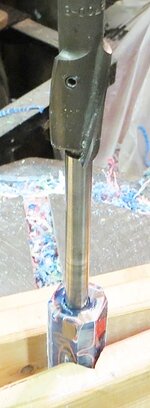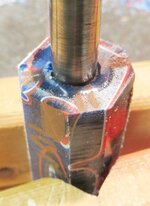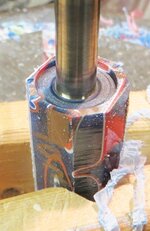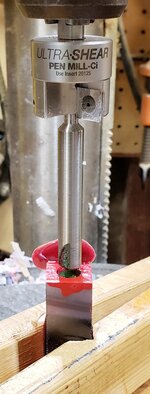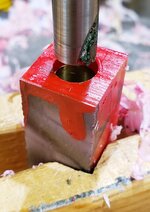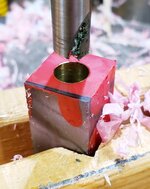So when I first started pen turning, this question came to me. It still confuses me today, and I was hoping to get some insight on it. Why are pen mills 3/4" or less, and not 1"-1-1/4"? I don't understand why the mill is so small that it doesn't trim the entire blank, but rather leaves a circular hole that I need to sand down.
You are using an out of date browser. It may not display this or other websites correctly.
You should upgrade or use an alternative browser.
You should upgrade or use an alternative browser.
Pen Mill (and my question about it's use)
- Thread starter xCykax
- Start date
Signed-In Members Don't See This Ad
Signed-In Members Don't See This Ad
It costs more to make a larger diameter cutter head.
Also, the peripheral (edge) speed increases as the size (radius) increases.
At the outer edge, that could push the speed higher (for larger cutter) than the optimal for cutting some materials.
Also, the peripheral (edge) speed increases as the size (radius) increases.
At the outer edge, that could push the speed higher (for larger cutter) than the optimal for cutting some materials.
Last edited:
philipff
Member
I do not use pen mills. I found them inadequate in several applications What I use to square up the ends is Round End Scraper! When sharpened properly you can take the workpiece down to a very fine match with almost no effort. But then, I am the odd guy who uses no bushings, only a precise measuring caliper to match the pieces perfectly. Try it and you will see what I mean, and it is of little or no cost. P.
wouldentu2?
Member
My experience is if the mill comes past the side of the blank it sometimes splits the wood. This happens on certain wood like walnut.
1080Wayne
Member
Perhaps a couple reasons . 15 years ago , most blanks were 5/8 square , which is covered by a 3/4 mill . Making one large enough to cover a 1 inch blank raises the peripheral speed quite a bit at the same rpm , and increases the chance of wrecks . A lot of us have had too many of those with the 3/4 mills , so we have gone to sanding systems instead . There are many discussions on the topic in this forum .
1080Wayne
Member
Search `blank end sanding` and you will get a bunch of different sanding approaches .
Here is one https://www.penturners.org/threads/sanding-the-ends-square.164557/
Here is one https://www.penturners.org/threads/sanding-the-ends-square.164557/
monophoto
Member
It costs more to make a larger diameter cutter head.
Also, the peripheral (edge) speed increases as the size (radius) increases.
At the outer edge, that could push the speed higher (for larger cutter) than the optimal for cutting some materials.
Both are valid reasons, but there is one additional factor - finished pens are rarely more than 1/2" in diameter, so using a mill to trim a 5/8" diameter section of the end of the blank is more than sufficient. And the fact that means that an oversized blank will be trimmed to have a 5/8" diameter circular recess at each end prior to turning is totally irrelevant since everything outside that recess will be turned away.
In other words - there is no reason for the mill to be larger than 5/8" diameter, it would be more expensive to make it any larger, and if it were larger, it could be difficult to use.
In other words - there is no reason for the mill to be larger than 5/8" diameter, it would be more expensive to make it any larger, and if it were larger, it could be difficult to use.
Yes, indeed !! . But some turners like to keep the cross-section of the blank they are working with as large as poss. for as long as poss.
However, to completely trim the end on even a 3/4" sq. blank you need a cutter which is close to 1.1" diameter and that is borderline.
(.... just the geometry of a 3/4" square dictates this ....)
For myself, I do the end squaring on a metal lathe which is extremely easy and accurate using the cross-feed.
It helps if you can do the end squaring after rounding the blank .... might require modifying your usual "habitual routine".
I cringe when I see end-squaring done with the blank still square .... however, that might be necessary for some at some time.
Last edited:
DrD
Member
Need your help here. Because of wanting squared up ends, my blanks are longer than the tubes. The net of this is that the guide bushings don't go all the way into the tube if not squared before turning. Is this going to result in "off center" seating of the bushing. I ask this because I had the end squaring process for a lot of reasons beyond the pale of this discussion. Not intending to hijack thread - SORRY!!!Yes, indeed !! . But some turners like to keep the cross-section of the blank they are working with as large as poss. for as long as poss.
However, to completely trim the end on even a 3/4" sq. blank you need a cutter which is close to 1.1" diameter and that is borderline.
(.... just the geometry of a 3/4" square dictates this ....)
For myself, I do the end squaring on a metal lathe which is extremely easy and accurate using the cross-feed.
It helps if you can do the end squaring after rounding the blank .... might require modifying your usual "habitual routine".
I cringe when I see end-squaring done with the blank still square .... however, that might be necessary for some at some time.
monophoto
Member
Need your help here. Because of wanting squared up ends, my blanks are longer than the tubes. The net of this is that the guide bushings don't go all the way into the tube if not squared before turning. Is this going to result in "off center" seating of the bushing. I ask this because I had the end squaring process for a lot of reasons beyond the pale of this discussion. Not intending to hijack thread - SORRY!!!
Normally, the OD of the bushings should be less than the diameter of the mortise cut into the end of the blank by the pen mill, so the bushings should always fit inside that mortise.
However, if you are working with a special case where the final diameter of the pen is greater than the 5/8" diameter of a pen mill, then perhaps you should look at some other means of squaring the ends of the blank. Some people prefer to use disc sanders.
@DrD
I will answer you in a "conversation" if you will start one to me.
Please copy and paste your last post to me .... I will then answer.
Also, before you send that to me, please read and correct (words missing, I think). . I am not quite understanding because of words missing
in the second to last long sentence. . Please read and correct, if you can remember what you meant to say.
Mal
I will answer you in a "conversation" if you will start one to me.
Please copy and paste your last post to me .... I will then answer.
Also, before you send that to me, please read and correct (words missing, I think). . I am not quite understanding because of words missing
in the second to last long sentence. . Please read and correct, if you can remember what you meant to say.
Mal
lorbay
Member
And why do you need a mill larger than your largest bushing. ??
Lin
Lin
@lorbay
Lin,
If you are asking me ... I don't know ... that part of the discussion was not initiated by me ... I am just trying to answer a questions which is probably related to the OP.
I think that the OP is thinking it would be nice to trim (squarely) the full cross-section of a square blank, no matter what size it will eventually be turned down to.
Mal
Lin,
If you are asking me ... I don't know ... that part of the discussion was not initiated by me ... I am just trying to answer a questions which is probably related to the OP.
I think that the OP is thinking it would be nice to trim (squarely) the full cross-section of a square blank, no matter what size it will eventually be turned down to.
Mal
qquake
Member
I have tried sanding, both with a jig on my disc sander, and a jig on my lathe. Don't like either method. I have used several commercial pen mills, over the years, and also a piloted end mill with custom pilots my b-in-law made for me over 10 years ago. My current favorite is the relatively new, and very expensive, Woodpeckers Ultra-Shear carbide pen mill. It uses carbide cutter inserts. The cutting face is a little bigger than most pen mills, at approximately 1.09". One thing I don't like about it, is they don't have all the pilots (13/32" and 25/64", to name two).
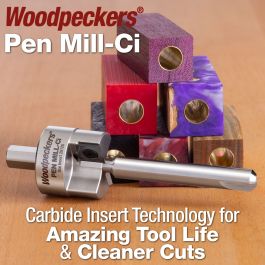
 www.woodpeck.com
www.woodpeck.com

Pen Mill Ci – Carbide Inserts for Amazing Tool Life and Cleaner Cuts
Creating beautiful turned pens starts with carefully preparing the turning blank. Pen kits includes a brass insert tube that has to be glued into the blank. Then the blank needs to be trimmed perpendicular to and perfectly flush with both ends of the insert tube. The trimming process is...
Attachments
Last edited:
mick
Member
I think it was mentioned in an earlier post above but the number one reason you want the pen mill to be smaller than the blank is because a mill bigger than the blank will rip the corners right off a wooden blank effectively wrecking it.
You will rarely if ever find bushings that won't fit into that 5/8 " milled end.
Sent from my SM-G955U using Tapatalk
You will rarely if ever find bushings that won't fit into that 5/8 " milled end.
Sent from my SM-G955U using Tapatalk
Paul in OKC
Member
I have always used a pen mill. I made one years ago with a HSS aircraft spot facing tool. It is 1 1/4" diameter. Made my own pilot for the slim lines and made sleeves for the other sizes I needed. I do like the look of the Woodpecker trimmer. Might consider buying just the head and one shaft and make sleeves for what you need.

